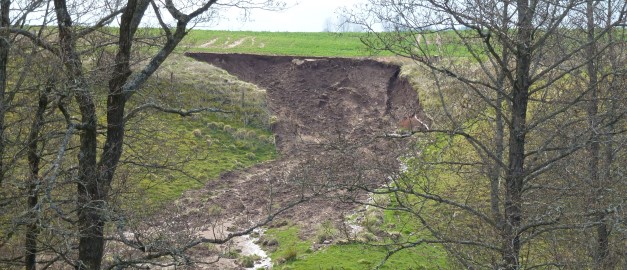
Photo: Åsa Lindh, SGU.
Hazards
Geological information can be used to try to prevent and minimise the effects of various types of hazards.
Good physical planning requires us to take into account both the hazards that exist in nature and those that we ourselves have created. Where is the land prone to slide, which areas have high radon concentrations in the soil, how vulnerable is our drinking water supply and where do the soil and groundwater contain high levels of harmful substances?
What’s in the soil and in the water?
Soil and water contain metals and other substances that are present naturally or have been introduced through human activity. For example, planning new residential areas or deploying measures in wells with bad water requires information both about the substances naturally occurring and the substances introduced through human influence.
SGU's geochemical information, i.e. information on the soil's content of various substances, can be used to identify areas with properties such as elevated concentrations of metal (natural or anthropogenic) and areas with low pH.
Protecting our most important foodstuff
Water is one of our most important foodstuffs. When a risk of contamination or poisoning arises, society must know where there are surface and groundwater reserves. In order to eliminate risks as far as possible and to produce plans for dealing with an accident, the vulnerability of drinking water supplies must be mapped in advance.,. For example, an assessment of the measures to be deployed if a petrol truck overturns near a groundwater supply requires information on soil permeability and the groundwater's flow direction.
Groundwater might also be affected by climate change.
Natural radioactivity and soil radon
People are constantly exposed to ionising radiation. The majority of this radiation comes from natural sources - radon in indoor air and radiation from the ground.
Radiation from the ground comes mainly from the decay of the naturally occurring elements potassium, uranium and thorium. The concentrations of these elements in bedrock and soil strata vary, which means that the radiation varies from place to place.
The variation of natural radiation in Sweden can be seen on the maps viewers for potassium, uranium and thorium.
Sweden's bedrock is relatively rich in uranium. Rocks that may have elevated concentrations of uranium include alum shale and various granites. Uranium is radioactive and decays in several steps. One step in the decay chain is radon.
Radon in indoor air can come from the soil, from building materials or from water
The radon concentration should not exceed 200 Bq/m³ in dwellings, schools and public premises (Public Health Agency of Sweden guideline value). The radon hazard is regarded as linear, which means that a radon concentration of 400 Bq/m3 is twice as dangerous as 200 Bq/m3. All radon buildings should be traced, but it is of primary importance to trace buildings with high radon concentrations.
Radon from the soil is the most common source of radon in buildings. There is always enough radon in the soil for the radon concentration to exceed limit and guideline values if soil air can leak into a building.
Radon might also be present in drinking water, especially in water from wells drilled in the bedrock. Radon in water passes readily into indoor air when the water is used. Building materials can also emit radon.
Landslides, debris flows and rockfalls
Some soils, especially clayey soils on sloping ground or adjacent to water, are prone to landslides. Best of all is to avoid building on such sites, but if there are already buildings, there needs to be means of assessing the landslide risk and, where necessary, the measures to be deployed. This requires knowledge of soil properties and of the occurrence of previous landslides.
With the ongoing climate change, we can expect a higher frequency of torrential rains. High water stresses and pore-water pressures can also trigger mud-/debris flows and rockfalls.
SGU's soil geology databases can be used together with terrain and water flow information to assess the risk of landslides and rockfalls.
Acid sulfate soils
In areas where sulfidic sediments occur, acid sulfate soils are often formed, which can periodically lead to very adverse effects on watercourses. High metal concentrations and low pH may in certain situations lead to fish death.
Last reviewed 2020-09-21
